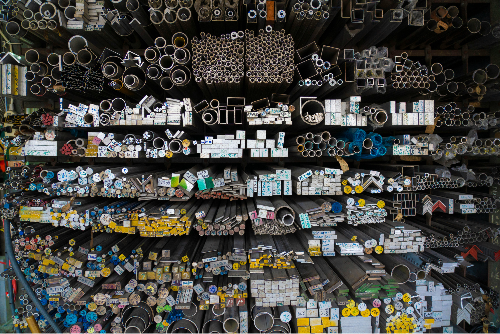We build Sustainable Urban Logistics Centers — in Timber!
- news and press

- Jun 19
- 4 min read
Building Sustainable Urban Logistics Centers — in Timber!
Over the next four years, Qonnected Logistics and Focus on Impact will collaborate on the development of 14 sustainable urban logistics centers. This initiative represents an investment of over €500 million and is aimed at future-proofing logistics in and for cities. Urban logistics significantly contributes to reducing CO₂ emissions and improving quality of life for city residents. The introduction of these urban logistics hubs will reduce construction-related traffic in urban areas by as much as 73%. This results in over 30% lower CO₂ emissions and a significant reduction in traffic congestion, noise pollution, and fine particulate matter.
However, a program with such impact would fall short if the distribution centers themselves weren’t built sustainably. That’s why timber construction has been chosen, carried out in accordance with the highest BREEAM-NL standards and fully aligned with the Paris Climate Agreement. Timber construction is not only ecologically responsible but also offers unique advantages over traditional construction methods using steel and concrete.

Why Build with Timber?
Timber construction is an innovative and future-oriented building method that excels in sustainability, speed, aesthetics, and circularity. In the context of sustainable urban logistics, timber construction aligns perfectly with the ambitions of Qonnected Logistics and Focus on Impact: to build functional, energy-efficient, and healthy buildings that contribute to a better environment — and better cities.
Benefits of Timber Construction vs. Traditional Construction
1. Sustainability and Environmental Friendliness
One of the strongest arguments for timber construction is its environmental benefit:
CO₂ Reduction: Unlike concrete and steel, which require high energy during production and emit significant CO₂, timber actually absorbs CO₂. During growth, a tree stores carbon, which remains locked in the building as long as the wood is in use. A timber building is a form of active climate compensation.
Renewable Resource: Wood is a natural, renewable material when sourced from responsibly managed forests. FSC or PEFC certification ensures that for every tree harvested, another is planted.
Low Environmental Impact: Producing timber components requires significantly less energy than producing steel or concrete. This results in lower embodied carbon — the hidden emissions during production and transport.
2. Faster, Cleaner, and More Efficient Construction
The logistics of timber construction align perfectly with the urban logistics principle:
Prefab and Industrialization: Timber construction uses prefabrication in a controlled factory environment, reducing on-site errors. Parts are custom-made and assembled on-site, shortening construction time and reducing urban transport.
Lightweight Structures: Timber is lighter than concrete and steel, allowing for lighter foundations. This saves time and cost and minimizes soil disruption — a major advantage in dense urban areas.
Quieter Construction Sites: Dry assembly and lighter machinery mean less disruption for surrounding areas, reducing noise and making the construction period more pleasant.
3. Healthy, Comfortable, and Appealing Buildings
Beyond sustainability, user well-being is a major benefit of timber construction:
Indoor Climate and Ventilation: Timber naturally regulates temperature and humidity, creating a more pleasant indoor environment and lowering energy use.
Aesthetics and Atmosphere: Wooden interiors feel warm, natural, and calming — proven to boost productivity, health, and well-being.
Light and Acoustics: Wood reflects light softly and naturally dampens noise, enhancing comfort for logistics personnel.
4. Flexibility, Modularity, and Circularity
Timber construction is not only sustainable but highly adaptable:
Modular Design: Many timber projects are modular, allowing easy adjustments, expansions, or relocations. This makes real estate future-proof and adaptable to changing needs.
Demountable and Reusable: Timber structures can often be partially or fully disassembled. Materials can be reused or recycled — a key aspect of the circular building economy.
Minimal Waste: Prefabricated timber construction generates very little material waste, supporting BREEAM goals around waste management.
5. Social Value and Image
Choosing timber construction communicates ambition, responsibility, and innovation:
Sustainable Image: Companies and developers that choose timber construction position themselves as forward-thinking and environmentally responsible — increasingly important to investors, tenants, and municipalities.
ESG-Compliant Real Estate: Timber construction aligns perfectly with ESG (Environmental, Social & Governance) criteria. Real estate investors seeking sustainable and responsible projects are increasingly drawn to high-performance developments.
BREEAM-NL Certification: With focus areas like energy, water, waste, transport, and health, timber construction meets BREEAM-NL requirements, increasing market value and operational potential.
Aligned with the Paris Climate Agreement and BREEAM-NL
The Paris Climate Agreement demands significant emission reductions in the construction sector. Timber offers a direct and practical solution. Combined with solar panels, heat pumps, LED lighting, rainwater harvesting, EV charging infrastructure, and green roofs, these urban logistics centers are being developed as energy-efficient and future-ready buildings.
Qonnected Logistics’ projects are also developed according to BREEAM-NL guidelines, which assess not just the building but also its surroundings, biodiversity, and construction processes.
Conclusion
The choice for timber construction in this ambitious urban logistics program is not a trend — it's a conscious, necessary, and strategic decision. Timber construction directly lowers the carbon footprint, enables more efficient building, and creates healthy, comfortable, and aesthetically pleasing work environments. It allows Qonnected Logistics and Focus on Impact to not only green logistics, but also the building process itself — setting an example for the future of urban development.
By choosing timber construction, we’re not just building smarter — we’re building for better living in our cities.
More about timber construction: https://www.nicedevelopers.nl/
More about urban logistics centers: https://www.q-realestate.nl/


_edited.png)
_edited.png)
_edited.png)


_edited.png)
_edited_edited.png)









_edited.png)



Comments